
Associate Professor Luca Fiorenza
Head of the Palaeodiet Research
Luca received his Bachelor/Master degree in Natural Sciences in 2003 at La Sapienza University in Rome (Italy), and completed his PhD in Biological Sciences between the Goethe University and the Senckenberg Research Institute (Frankfurt, Germany) at the end of 2009. During his doctoral degree he was part of an outstanding multidisciplinary network called EVAN (European Virtual Anthropology Network), where he mastered cutting-edge techniques for the study of anatomical variability, including medical imaging, 3D digitisation, display, modelling and programming. Luca’s research interests mostly focus on functional morphology of the masticatory apparatus in human and non-human primates, and on the importance of the role of diet in human evolution.
Email: luca.fiorenza@monash.edu
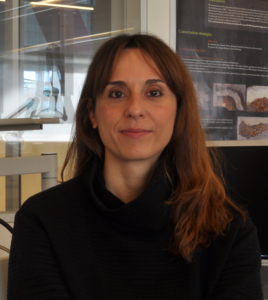
Dr Laura Martín-Francés
Marie Sklodowska-Curie postdoctoral fellow
Laura is a Marie Sklodowska-Curie postdoctoral fellow at CENIEH (Spain) and Monash University (Australia). Her research focuses in the pattern of settlement of hominin groups during the Early and Middle Pleistocene in Europe, with special interest in the western part. She applies morphometric techniques to the outer and inner dental tissues to investigate the appearance and evolution of the Neanderthal traits. Currently, Laura is at PalaeoDiet Lab (Monash University) conducting her EU-MSCA project BITE. The aim of this project is to evaluate how morphometric dental traits evolved to adapt to diet or cultural habits as well as the pace of these changes in phylogenetically related, and chronologically consecutive European groups. She will investigate complementary dental proxies (dental wear, morphology, and enamel thickness) to assess if the cranio-dental morphology of European groups truly correlate with biomechanical stress.
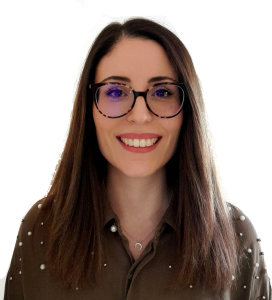
María Hernaiz García
PhD Candidate
María is currently doing her PhD on cranio-dental anatomy of Neanderthals and anatomically modern humans under the Biomedicine Discovery Scholarship, an international scholarship to recognise the excellence of Monash students from the Faculty of Medicine, Nursing and Health Sciences. The aim of her work is to examine the masticatory system of Neanderthals from a functional and biomechanical point of view. By carrying out 3D modelling of bones and teeth from a wide Neanderthal fossil sample and by virtually reconstruct the simulation of their chewing behaviour, she will be able to assess if Neanderthal cranio-dental morphology was truly adapted to resist powerful bite forces. This study is part of the “A real-time biomechanical study of Neanderthal anterior dentition” project (DP190100465) funded by the Australian Research Council (ARC).
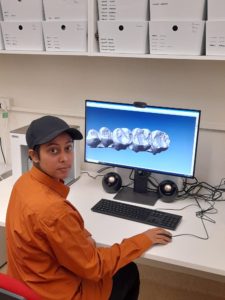
Tehreem Raza
PhD Candidate
Tehreem is currently doing her PhD on the “Diet in early hominins: a new look from a digital perspective” under the Monash Biomedicine Discovery Program. The aim of her work is to reconstruct the diet of early African hominins combining Occlusal Fingerprint Analysis method with dental topographic measurements. This study will be based on one of the largest samples of African hominin species ever assessed. She will examine the dental macrowear pattern of non-human primate species of known diet to infer the dietary habits of extinct hominin species. Moreover, for the first time, she will examine the macrowear patterns of deciduous molars to detect information on dietary changes between immature and adult individuals. This comprehensive study will advance our knowledge on how early hominins adapted to various feeding strategies to cope with habitat degradation associated with climatic changes.
Email: Tehreem.raza@monash.edu

Dr Ali Najafzadeh
Research Assistant
Ali is a Mechanical Engineer who received his Master’s degree from the University Tenaga National (UTN) in 2013 in Kuala Lumpur, Malaysia. Currently, he is a 3rd year PhD student at the Mechanical and Aerospace Engineering department at Monash University in Melbourne, Australia. His research expertise is in bio-mechanics focusing on bone fracture healing monitoring and assessment as well as orthopaedic implants design and analysis by the means of Finite Element Analysis (FEA) method. Ali is also helping with the ARC Project “A real-time biomechanical study of Neanderthal anterior dentition” (DP190100465). His contribution to this project is in understanding the evolution of the human dentition evolution by conducting engineering simulations using FEA.
Email: Ali.najafzadeh1@monash.edu
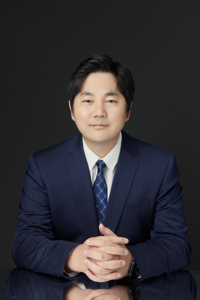
Dr Yu Gu
Research Visitor
Dr Yu Gu (D.D.S, M.S.D, Ph. D) is currently an associate professor at Shandong University, China. Dr Yu is a highly recognised international expert in dental anthropology and Endodontics, with an outstanding track record including publications in prestigious international scientific journals such as Archives of Oral Biology, Journal of Endodontics, and Acta Odontologica Scandinavica. Dr Yu was awarded a scholarship by China Scholarship Council which will support his research in our lab. the diet of prehistoric human populations from the Shandong region that occupied this area during different periods of time, ranging from the Neolithic (4th to 3rd millennium) to the Bronze and Iron Ages. In particular, this project will focus on how environmental changes have shaped the living conditions and physiological characteristics of these populations.
Email: Yu.Gu@monash.edu
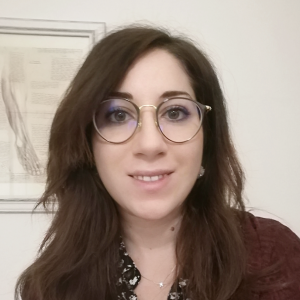
Dr Rita Sorrentino
Research Collaborator
Rita Sorrentino is a Post Doctoral researcher at the Department of Biological, Geological and Enviromental Sciences of the University of Bologna. Her studies are involved in both Physical Anthropology and Paleoanthropology. Currently, she is applying Geometric Morphometrics and Biomechanical trabecular methods in the analysis of foot bones to investigate the anatomical changes due to different mobility strategies in H. sapiens, as well as to better understand the evolutionary timing and appearance of modern human-like features and their contributions to bipedal locomotion. She uses virtual approaches for the Palaeodiet projects, such as 3D reconstruction and restoration, to analyze morpho-functionally bony features in extinct and extant hominins. Rita is currently helping us in producing high-resolution 3D models of Nanderthal and modern human teeth linked to the ARC Project “A real-time biomechanical study of Neanderthal anterior dentition” (DP190100465).
Email: rita.sorrentino2@unibo.it
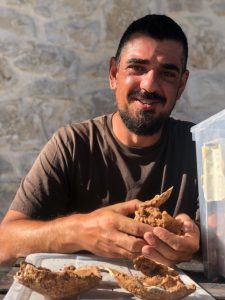
Dr Antonino Vazzana
Research Collaborator
Antonino Vazzana is an anthropologist at the Department of Cultural Heritage, University of Bologna. His main research interest is on palaeoanthropology, bioarchaeology and digital reconstruction. His research focuses on the study of the biological variability during the migration period in Late Antiquity through the analysis of biological distances. He uses virtual approaches and geometric morphometric methods for the purposes of bone reconstruction and shape analysis of skeletal remains. Antonino is currently helping us in producing high-resolution 3D models of Nanderthal and modern human teeth linked to the ARC Project “A real-time biomechanical study of Neanderthal anterior dentition” (DP190100465).
Email: antonino.vazzana2@unibo.it
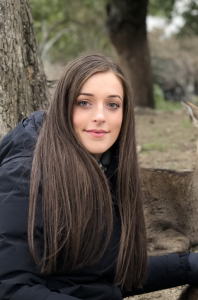
Palaeodiet Research Lab Alumni
Teagan Harty
Honours Student
Teagan’s honours research project involved investigating the relationship between craniodental morphology, primate diet and their ecology. Particularly, understanding the difference between the Mountain gorilla (Gorilla beringei beringei) and the lowland gorilla (Gorilla beringei graueri and Gorilla gorilla gorilla) subspecies and how their different ecology affects their tooth morphology. Teagan used Occlusal Fingerprint Analysis (OFA) to analyse molar macrowear; the well defined enamel polished wear facets caused by occlusal contact during the masticatory cycle. Her study will provide comparative data to reconstruct the diet of our early human ancestors.

Jinyoung Lee
Honours Student
Jinyoung’s honours research project examined how wear facets form and develop through time in Australian Aboriginal children from Yuendumu (Northern Territory) using the Occlusal Fingerprint Analysis method. Jinyoung used a series of dental stone casts collected between 1950’s and 1970’s that were part of a large longitudinal project concerned with the dentition and general growth of Australian aboriginal children. The Aboriginal people from the Yuendumu Reserve were at an early stage of transition from a nomadic and hunter-gatherer way of life to living on a settlement, and thus, they offered a unique opportunity to better understand the relationship between diet, environment, cultural habits and tooth wear.

Sarah Fung
Honours Student
Sarah’s project focused on functional and morphological analysis of the Carabelli trait (an additional cusp or tubercle that form on the mesio-lingual surface of permanent and deciduous maxillary molars) through Occlusal Fingerprint Analysis (OFA). Sarah used dental casts of Australian Aboriginal children belonging to the Yuendumu tribe, a population that lived in transition from a hunter-gatherer to modern lifestyle.
